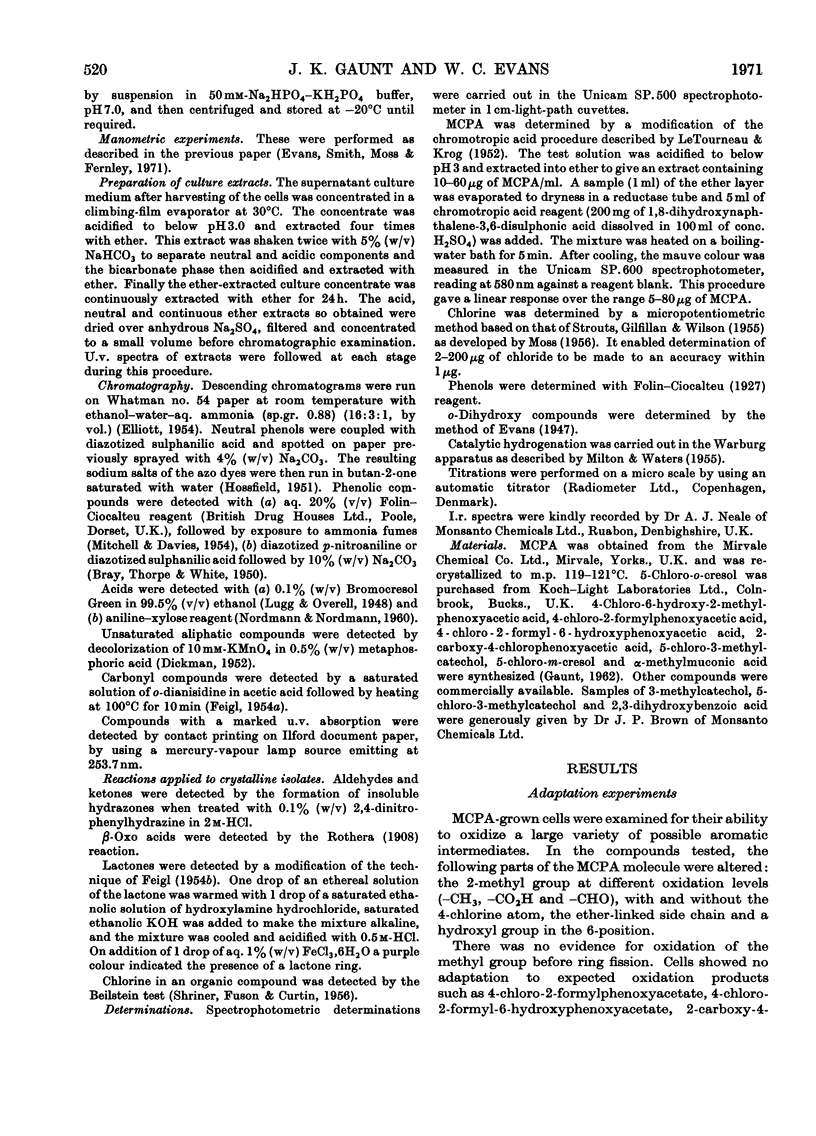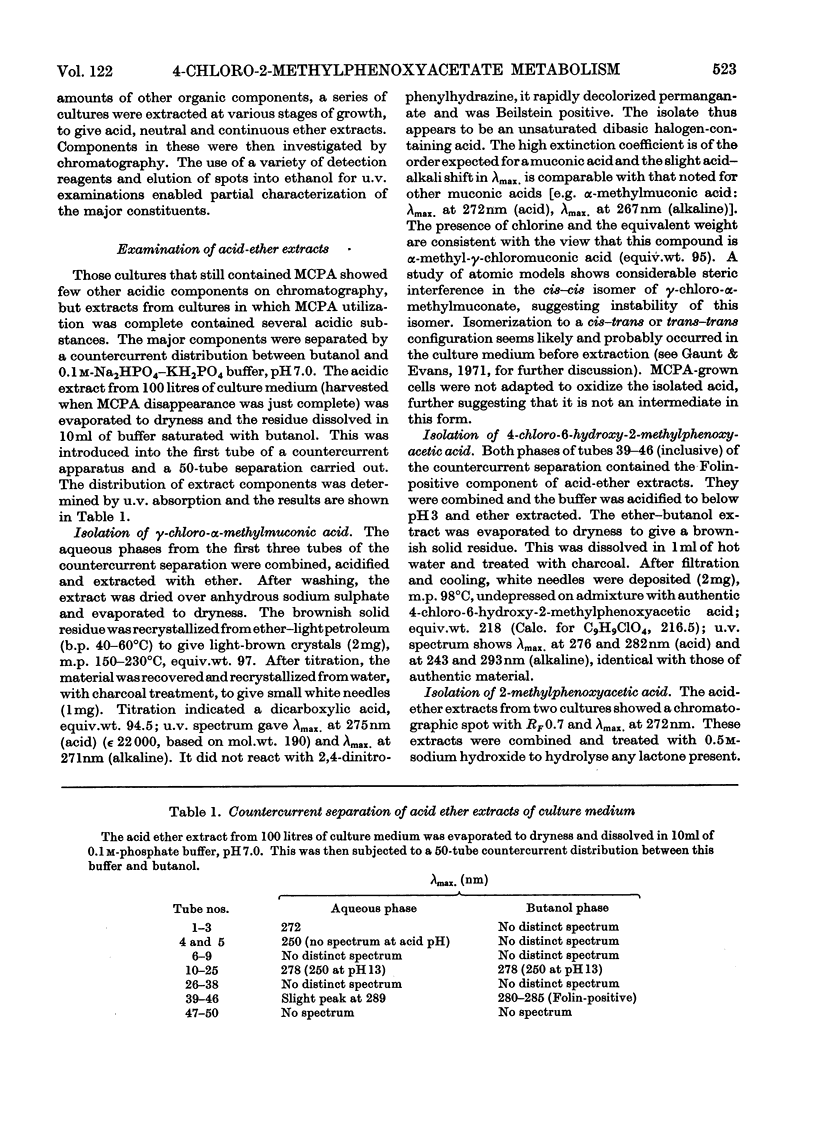Abstract
1. A pseudomonad capable of utilizing the herbicide 4-chloro-2-methylphenoxyacetate as a sole carbon source was isolated from soil and cultured in liquid medium. 2. Analysis of induction patterns of 4-chloro-2-methylphenoxyacetate-grown cells suggests that 5-chloro-o-cresol and 5-chloro-3-methylcatechol are early intermediates in the oxidation of 4-chloro-2-methylphenoxyacetate. Cells were not adapted to oxidize 4-chloro-6-hydroxy-2-methylphenoxyacetate. 3. In culture, 4-chloro-2-methylphenoxyacetate rapidly disappeared and the chlorine in the molecule was quantitatively released as Cl− ion. 4. A lactone (γ-carboxymethylene-α-methyl-Δαβ-butenolide) was isolated from cultures and established as an intermediate. 5. The following metabolic pathway is suggested: 4-chloro-2-methylphenoxyacetate → 5-chloro-o-cresol → 5-chloro-3-methylcatechol → cis–cis-γ-chloro-α-methylmuconate → γ-carboxymethylene-α-methyl-Δαβ-butenolide → γ-hydroxy-α-methylmuconate. 6. The tentative identification of 5-chloro-o-cresol, a γ-chloro-α-methylmuconate and γ-hydroxy-α-methylmuconate in culture extracts supports this scheme. However, the catechol was never observed to accumulate in cultures. 7. The detection of 4-chloro-6-hydroxy-2-methylphenoxyacetate, 2-methyl-phenoxyacetate, a dehalogenated cresol and oxalate in culture extracts is discussed in relation to the proposed metabolic pathway.
Full text
PDF







Selected References
These references are in PubMed. This may not be the complete list of references from this article.
- BELL G. R. Studies on a soil achromobacter which degrades 2,4-dichlorophenoxyacetic acid. Can J Microbiol. 1960 Jun;6:325–337. doi: 10.1139/m60-037. [DOI] [PubMed] [Google Scholar]
- Bollag J. M., Helling C. S., Alexander M. Metabolism of 4-chloro-2-methylphenoxyacetic Acid by soil bacteria. Appl Microbiol. 1967 Nov;15(6):1393–1398. doi: 10.1128/am.15.6.1393-1398.1967. [DOI] [PMC free article] [PubMed] [Google Scholar]
- Bray H. G., Thorpe W. V., White K. The fate of certain organic acids and amides in the rabbit. 10. The application of paper chromatography to metabolic studies of hydroxybenzoic acids and amides. Biochem J. 1950 Mar;46(3):271–275. doi: 10.1042/bj0460271. [DOI] [PMC free article] [PubMed] [Google Scholar]
- DAGLEY S., EVANS W. C., RIBBONS D. W. New pathways in the oxidative metabolism of aromatic compounds by microorganisms. Nature. 1960 Nov 12;188:560–566. doi: 10.1038/188560a0. [DOI] [PubMed] [Google Scholar]
- Evans W. C., Smith B. S., Moss P., Fernley H. N. Bacterial metabolism of 4-chlorophenoxyacetate. Biochem J. 1971 May;122(4):509–517. doi: 10.1042/bj1220509. [DOI] [PMC free article] [PubMed] [Google Scholar]
- FAULKNER J. K., WOODCOCK D. METABOLISM OF 2,4-DICHLOROPHENOXYACETIC ACID ('2,4-D') BY ASPERGILLUS NIGER VAN TIEGH. Nature. 1964 Aug 22;203:865–865. doi: 10.1038/203865a0. [DOI] [PubMed] [Google Scholar]
- Gaunt J. K., Evans W. C. Metabolism of 4-chloro-2-methylphenoxyacetate by a soil pseudomonad. Ring-fission, lactonizing and delactonizing enzymes. Biochem J. 1971 May;122(4):533–542. doi: 10.1042/bj1220533. [DOI] [PMC free article] [PubMed] [Google Scholar]
- Letourneau D., Krog N. THE USE OF CHROMOTROPIC ACID FOR THE QUANTITATIVE DETERMINATION OF 2,4-DICHLOROPHENOXYACETIC ACID. Plant Physiol. 1952 Oct;27(4):822–827. doi: 10.1104/pp.27.4.822. [DOI] [PMC free article] [PubMed] [Google Scholar]
- MACDONALD D. L., STANIER R. Y., INGRAHAM J. L. The enzymatic formation of beta-carboxymuconic acid. J Biol Chem. 1954 Oct;210(2):809–820. [PubMed] [Google Scholar]
- MITCHELL F. L., DAVIES R. E. The isolation and estimation of the steroid oestrogens in placental tissue. Biochem J. 1954 Apr;56(4):690–698. doi: 10.1042/bj0560690. [DOI] [PMC free article] [PubMed] [Google Scholar]
- Rothera A. C. Note on the sodium nitro-prusside reaction for acetone. J Physiol. 1908 Dec 15;37(5-6):491–494. doi: 10.1113/jphysiol.1908.sp001285. [DOI] [PMC free article] [PubMed] [Google Scholar]
- STEENSON T. I., WALKER N. The pathway of breakdown of 2:4-dichloro- and 4-chloro-2-methyl-phenoxyacetic acid by bacteria. J Gen Microbiol. 1957 Feb;16(1):146–155. doi: 10.1099/00221287-16-1-146. [DOI] [PubMed] [Google Scholar]


